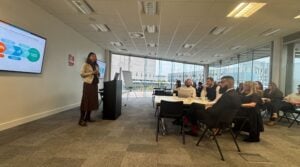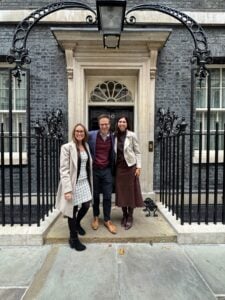Learning Without Borders
The drive to improve outcomes for every child transcends geography. Around the world, communities are aligning around shared goals for young people and creating systems that reflect a common purpose.
During our time in the United Kingdom, Bridget Jancarz, vice president of network impact at StriveTogether, and I met with The Reach Foundation and their partners to see how place-based, cradle-to-career work is being adapted in a new context. We were reminded that while our systems may differ, our vision is the same: every young person should have every opportunity to thrive.
Our connection with Reach began several years ago, when one of their trustees visited StriveTogether to learn about our model for systems transformation. That initial conversation sparked an exchange that has since grown into a thriving movement. Dozens of schools and communities across England are now working collectively to improve outcomes for children and families.
 From the start of our visit, I felt a deep sense of kinship. The systems may be structured differently, but their purpose is the same. The leaders we met share our commitment to breaking down barriers, aligning partners and making decisions grounded in data and opportunity.
From the start of our visit, I felt a deep sense of kinship. The systems may be structured differently, but their purpose is the same. The leaders we met share our commitment to breaking down barriers, aligning partners and making decisions grounded in data and opportunity.
Led by Ed Vainker, Mei Lim and James Townsend, the Reach Foundation supports a network of schools and partners that are aligning around shared outcomes for children. Much like our Cradle to Career Network in the U.S., they are using data to understand what works, building trust across sectors and focusing on results.
One key difference is where this work begins. In the U.K., schools often serve as the central hub for place-based collaboration. Head teachers, trust directors and principals take on the convening role that community partnerships often play in the U.S. Seeing schools lead this work offered valuable perspective on how leadership and accountability can look different depending on context and how universal the desire for collective progress truly is.
Seeing Cradle-to-Career in Action
Our first two days were filled with learning and dialogue. We began with a visit to the Children’s Commissioner for England, whose office protects and promotes the rights of children. Their focus on listening to young people and using data to influence policy deeply resonated with us. It mirrored our own belief that systems must respond to the lived experiences of the children and families they serve.
 Later, we led a Place-Based Partnerships 101 session with the U.K.’s emerging cradle-to-career network — a gathering of educators, foundation leaders and local organizations eager to learn how collective impact can drive measurable improvement. We shared the StriveTogether Theory of Action™, our data-driven approach to continuous improvement and stories of communities in the U.S. that are translating collaboration into real results.
Later, we led a Place-Based Partnerships 101 session with the U.K.’s emerging cradle-to-career network — a gathering of educators, foundation leaders and local organizations eager to learn how collective impact can drive measurable improvement. We shared the StriveTogether Theory of Action™, our data-driven approach to continuous improvement and stories of communities in the U.S. that are translating collaboration into real results.
The following day, we spent time with trust leads, roughly the equivalent of superintendents, exploring how school networks can use shared accountability and differentiated responsibility to strengthen outcomes. Bridget facilitated a powerful conversation about what it means to move from collaboration to action and how communities can focus on results that truly change lives.
We also had the extraordinary opportunity to meet at 10 Downing Street with the Prime Minister’s Expert Adviser on Skills and Education. Our conversation centered on preparing young people for meaningful career pathways that connects education to employment and ensure every student has access to opportunity. We shared examples from across our network, including how partnerships are bringing schools, employers and workforce systems together to create clear, supported routes to good jobs.
 A Culture That Lives Its Values
A Culture That Lives Its Values
At Reach Academy Feltham, we saw what cradle-to-career partnership looks like in action. The school serves children from age 2 through 18 and radiates a sense of purpose and belonging. Teachers and students interacted with respect, care and curiosity, each conversation reflecting a shared belief in what’s possible.
What we witnessed was a culture built on connection. Students felt seen and supported, and educators approached their work as a collective responsibility. It reminded me that systems change begins in moments like these. When relationships are strong, trust is visible and every person knows they have a role to play in helping young people succeed. This is what cradle-to-career partnerships are ultimately about: aligning people, institutions and energy around a shared vision of possibility.
 We ended the week in Birmingham, co-presenting with the Reach Foundation at the Confederation of School Trusts (CST) Annual Conference, one of the largest gatherings of education leaders in the U.K. More than a thousand educators, policymakers and practitioners attended. Together, we shared lessons from StriveTogether’s 14 years of supporting place-based partnerships, highlighting how U.S. communities have turned shared vision into measurable results.
We ended the week in Birmingham, co-presenting with the Reach Foundation at the Confederation of School Trusts (CST) Annual Conference, one of the largest gatherings of education leaders in the U.K. More than a thousand educators, policymakers and practitioners attended. Together, we shared lessons from StriveTogether’s 14 years of supporting place-based partnerships, highlighting how U.S. communities have turned shared vision into measurable results.
The response was overwhelmingly positive. Many leaders told us how transformative it was to see a framework that unites rather than fragments. To see one that centers collaboration, opportunity and data as the foundation for systemic change.
A Global Movement for Change
As I reflect on our time in the U.K., one truth stands out. Our challenges and our hopes are more alike than different.
The systems may vary. U.K. schools are more consistently funded, while U.S. communities often rely on local resources. But the questions we ask are the same: How do we ensure that every child is seen, supported and successful? How do we build systems that expand opportunity for all young people, rather than reproducing gaps in access and outcomes?
 This trip reaffirmed that StriveTogether’s approach connects communities everywhere. It’s driven by people and their shared commitment to change. The principles of shared accountability, continuous improvement and collective action can thrive anywhere that communities are ready to work differently. Seeing that commitment come to life in another country reminded me that progress knows no borders. Whether in Feltham or Baltimore, it begins when communities hold both high expectations and deep care for every child.
This trip reaffirmed that StriveTogether’s approach connects communities everywhere. It’s driven by people and their shared commitment to change. The principles of shared accountability, continuous improvement and collective action can thrive anywhere that communities are ready to work differently. Seeing that commitment come to life in another country reminded me that progress knows no borders. Whether in Feltham or Baltimore, it begins when communities hold both high expectations and deep care for every child.
For StriveTogether, this experience underscored three things:
-
-
- Our work travels. The same approach that drives results in U.S. communities can inspire systems change globally. The Reach Foundation’s work is proof of that.
- We are both teachers and learners. Seeing schools at the center of this work challenged us to think differently about where leadership lives and reminded us that transformation starts locally.
- Our vision is expanding. We’ve long aimed to improve outcomes for 4 million young people in the U.S., but “all kids” means all kids — everywhere. Our learning and partnerships can help fuel a global movement for greater opportunity.
-
I left the U.K. inspired by our colleagues at the Reach Foundation and their partners. The week reminded me that we’re part of something larger than any one organization or country. When we learn and lead together, we move closer to a world where every child, in every community, has the opportunity to thrive.






